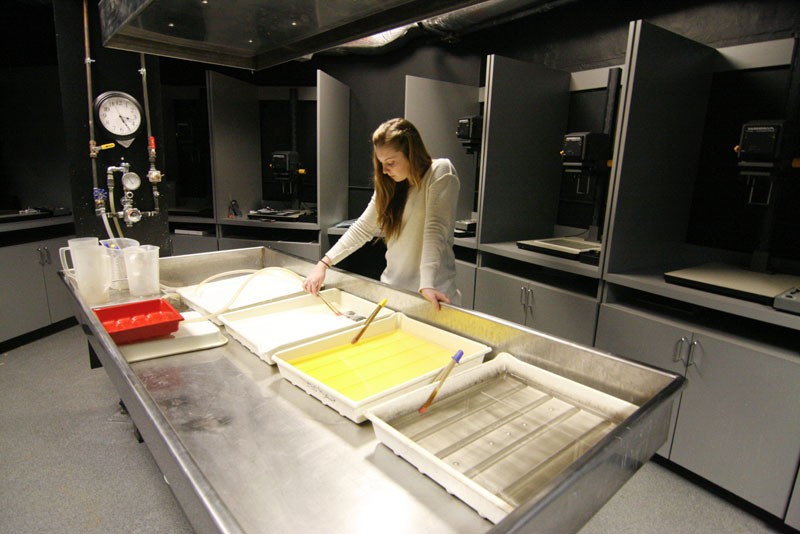Chem department works to limit waste

GVL / Andrea Baker Art and photography student Blaire Bancroft hard at work in the gang darkroom located in Lake Superior Hall. The chemical waste is disposed according to standards
Mar 15, 2012
In an attempt to reduce hazardous and landfill waste produced by Grand Valley State University’s chemistry department, the department has been thinking sustainably — all the way down to using starch packing peanuts that dissolve
in water instead of Styrofoam ones.
“[The] chemistry department takes great care for the environment and our budget,” said Michelle DeWitt, lab supervisor. “Contrary to public opinion, chemistry professionals care about the environment, and thus are always looking for ways to improve the way we teach our experiments and run our labs. We love to experiment with new methods and technologies.”
The department has switched from mercury to digital thermometers and categorizes metals into hazardous and nonhazardous categories to save money when disposing them.
Jim Seufert, lab safety specialist for the College of Liberal Arts and Sciences, said an important component of this hazardous waste is working hard to get inventory on every chemical in storage.
“What we all try to do is reduce the quantity of unused [chemicals],” Seufert said. “Old bottles are expensive to get rid of. Our goal is to reduce some chemicals.”
He added that if the quantity is not necessary, it is best if the department does not keep the substances around. However, he said he does not want to discourage anybody doing an experiment in an academic or research situation from using chemicals.
Sustainable efforts also include converting plastic cups from summer orientations into polylactic acid, an all-purpose cleaning solution. Chemistry students Patrick Clark and Adam Boyden collect these cups, wash them and turn them over to chemistry professor Matthew Hart and the Chemistry Club so the cups can be converted into the acid. Last summer, 1044 cups from water and lemonade were collected, DeWitt said.
“We have reduced not just hazardous waste but also paper, cardboard waste and batteries through recycling,” she said. “We try to limit our landfill waste by rewashing weigh boats, test tubes and plastic droppers.”
The department is also looking to save a few trees by providing laptops in some chemistry labs and allowing students to enter findings and answer questions on the online program WebAssign, rather than use printed paper.
Seufert said waste disposal costs collected in June 2010 amounted to $4,200, compared to $3,900 in June 2011. He added that Padnos Hall of Science is always the largest waste generator.
All of the faculty and staff have been making strides in the sustainability direction for many years, DeWitt said. For example, special microwave is used in organic labs to reduce and eliminate solvent use in extractions and distillations.
“We switched from macro distillations to micro distillation around 2000 and then in the fall of 2011, we started with phasing in the microwave experiments,” she said. DeWitt described the sustainable efforts as “very effective” and said they will “continue to improve.”
“One of the future endeavors being proposed by Professor Krikke and Dr. Kovacs is a S3 proposal to take used coffee grounds and do an extraction for biodiesel and still compost what is left from the grounds; this will let the students get one more use out of coffee,” DeWitt said. “The members of the chemistry department are continually looking to develop professionally and regularly attend conferences to get ideas from other universities to try here.”























